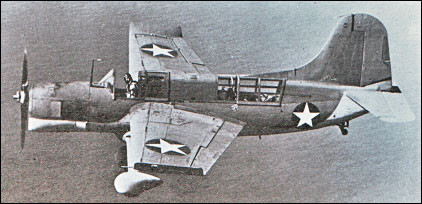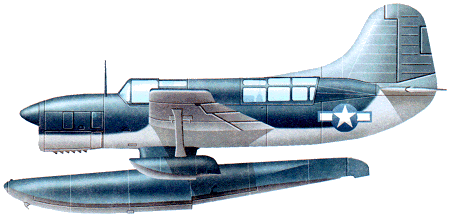 |
Curtiss Model 82 / SO3C Seamew1939 |  |
| SCOUT/OBSERVATION AIRCRAFT | Virtual Aircraft Museum / USA / Curtiss |
 |
In 1937 the US Navy invited proposals for the design of a scout monoplane which would offer improved performance over the Curtiss SOC Seagull then in operational service. It was required for operation from either ships at sea or land bases, which meant that easily interchangeable float/wheel landing gear was essential. From the proposals received both Curtiss and Vought were awarded prototype contracts in May 1938 under the respective designation XSO3C-1 and XSO2U-1. The latter prototype (1440), powered by a 410kW Ranger XV-770-4 engine, was duly flown in competition, but it was the Curtiss Model 82 design which was ordered into production. Despite this, the XSO3C-1 had serious instability problems. These were resolved finally by the introduction of upturned wingtips and increased tail surfaces, but the resulting aircraft in its landplane form was almost certainly the ugliest aircraft to be produced by the Curtiss company. Of all-metal construction, except for fabric-covered control surfaces, the XSO3C-1 had a crew of two accommodated in tandem enclosed cockpits. Floatplane landing gear comprised a large single-step central float and strut-mounted wingtip stabiliser floats and the wheeled landing gear was conspicuous by having large streamlined fairings. The prototype XSO3C-1 flew for the first time on 6 October 1939, and it and the Model 82A production SO3C-1 initially named Seagull, were powered by a 388kW Ranger V-770-6 engine. SO3C-1 production aircraft began to enter service on board the USS Cleveland in July 1942, and 300 were built before production switched to the SO3C-2. This Model 82B differed in having equipment for carrier operations, including an arrester hook, plus an underfuselage rack on the landplane version to mount a 227kg bomb. Production of this model totalled 456, of which 250 were allocated to the UK under Lend-Lease, although British records would seem to suggest that only 100 were received. Designation of the version intended originally for the Royal Navy was SO3C-1B (Model 82C), but those actually delivered were of the SO3C-2C variant with a more powerful engine, hydraulic brakes for aircraft with wheeled landing gear and other refinements. In British service these aircraft were designated Seamew, a name adopted subsequently by the US Navy, but none were used operationally in Great Britain. Instead, they equipped Nos 744 and 745 Training Squadrons, based at Yarmouth, Canada and Worthy Downs, Hampshire respectively, for the instruction of air gunners/wireless operators. The unsatisfactory performance of the SO3C-1 in the US Navy led to their withdrawal from first-line service. Many were converted for use as radio-controlled targets under the designation SO3C-1K, 30 being assigned to the UK, by whom they were designated Queen Seamew and used to supplement the fleet of de Havilland Queen Bee target aircraft. In an attempt to retrieve the situation, Curtiss introduced in late 1943 a lighter-weight variant equipped with the more powerful SGV-770-8 engine; designated SO3C-3 (Model 82C), only 39 were built before production ended in January 1944. Plans to introduce an SO3C-3 variant with arrester gear, and production by the Ryan Aeronautical Corporation of SO3C-1s under the designation SOR-1, were cancelled. FACTS AND FIGURES © The V-12 Ranger engine as used in the SO3C lacked the reliability of the company's six-cylinder inline models and was notorious for failure, causing numerous crashes. © For storage before launch on battleship and cruiser catapults, the Seamew had folding wings. © The leading edge fin fillet was attached to the rear canopy section and moved back and forth as it opened and closed. This reduced the effective fin area and thus the lateral stability. © To replace the Queen Bee radiocontrolled target version of the Tiger Moth, the UK converted about 30 SO3Cs as Queen Seamews for the same role. © The production Seamew had unusual upturned wingtips, where it probably should have had root-to- tip dihedral.

|  COMPANY PROFILE | ||||||||||||||||||||||||||||||||||||||||||||||||||||||||||||
 |

|

